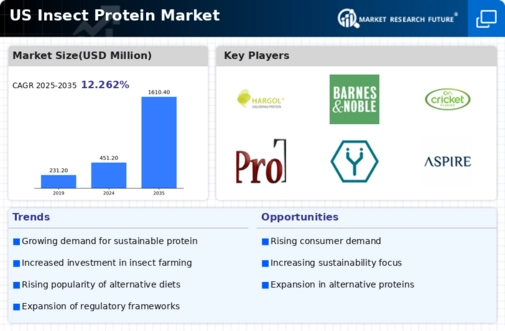Supportive Regulatory Frameworks
The insect protein market is experiencing favorable conditions due to supportive regulatory frameworks that facilitate the approval and commercialization of insect-based products. Regulatory bodies in the United States are increasingly recognizing the potential of insect protein as a safe and sustainable food source. Recent guidelines have streamlined the approval process for insect farming and processing, which may encourage more entrepreneurs to enter the market. This regulatory support is crucial for building consumer trust and acceptance, as it ensures that insect protein products meet safety and quality standards. As regulations continue to evolve, they are likely to create a more conducive environment for growth in the insect protein market, enabling it to reach a broader audience.
Rising Protein Consumption Trends
The insect protein market is expected to grow as protein consumption trends continue to rise in the United States. With an increasing number of consumers adopting high-protein diets, the demand for alternative protein sources is expanding. Reports indicate that the protein market is projected to reach $50 billion by 2027, with a notable segment attributed to insect protein. This trend is particularly evident among health-conscious consumers exploring diverse protein sources. The versatility of insect protein, which can be incorporated into various food products, positions it as a viable option to meet the evolving dietary preferences of the population. As awareness of the nutritional benefits of insect protein grows, it is likely to capture a larger share of the protein market.
Growing Awareness of Environmental Impact
The insect protein market is seeing increased interest due to awareness of the environmental consequences of traditional livestock farming. As consumers become more informed about the carbon footprint and resource intensity of conventional protein sources, they are turning towards alternatives like insect protein. This shift is supported by studies indicating that insect farming requires significantly less land and water compared to traditional livestock, with estimates suggesting a reduction of up to 80% in land use. Furthermore, insects produce fewer greenhouse gases, making them a more sustainable option. This growing consciousness among consumers is likely to drive demand in the insect protein market, as individuals seek to make environmentally responsible choices in their diets.
Increasing Interest from Food Manufacturers
The insect protein market is witnessing heightened interest from food manufacturers who are exploring innovative ways to incorporate insect protein into their product lines. As consumer preferences shift towards healthier and more sustainable options, food companies are recognizing the potential of insect protein as a functional ingredient. This trend is reflected in the growing number of products featuring insect protein, ranging from protein bars to snacks and baked goods. Market data suggests that the inclusion of insect protein can enhance the nutritional profile of products while appealing to environmentally conscious consumers. As food manufacturers continue to experiment with insect protein, it is likely to gain traction in mainstream markets, further propelling the growth of the insect protein market.
Technological Advancements in Farming Practices
The insect protein market is benefiting from technological advancements that enhance farming practices and production efficiency. Innovations in breeding, feed optimization, and automated farming systems are making insect farming more viable and cost-effective. For instance, the use of controlled environments and smart farming technologies can significantly increase yield and reduce production costs. As these technologies become more accessible, they are likely to attract investments and drive growth in the insect protein market. Additionally, improved farming practices can lead to higher quality protein products, which may further appeal to consumers seeking nutritious and sustainable food options. This technological evolution is expected to play a crucial role in shaping the future of the insect protein market.

















Leave a Comment